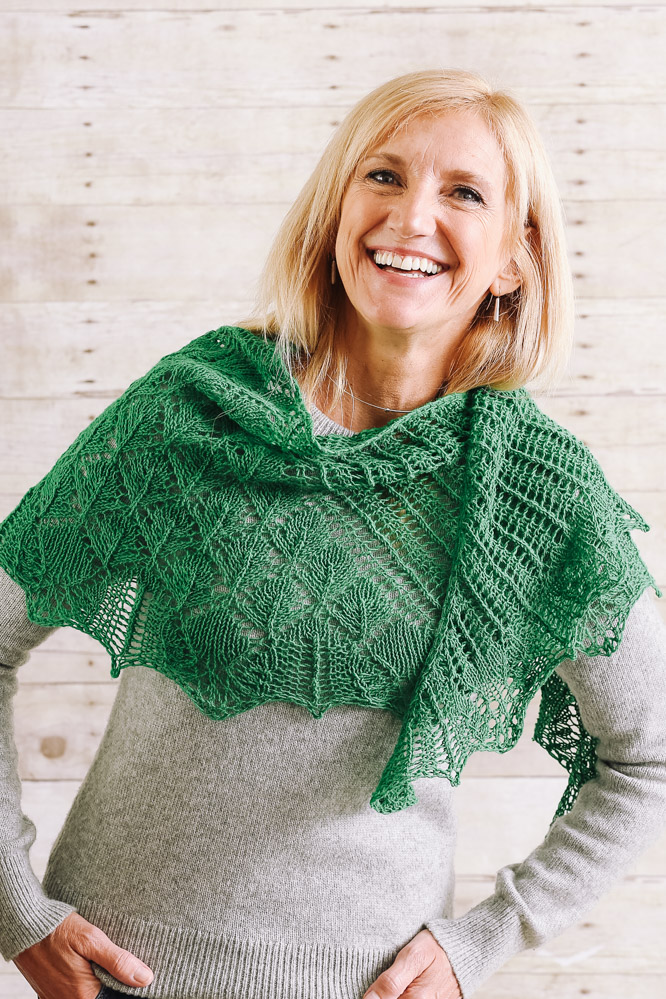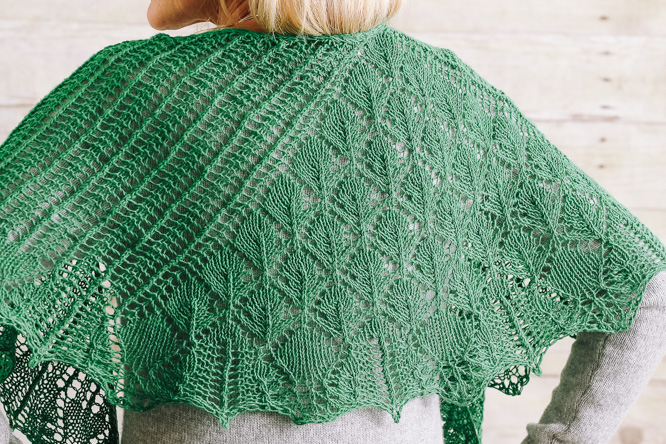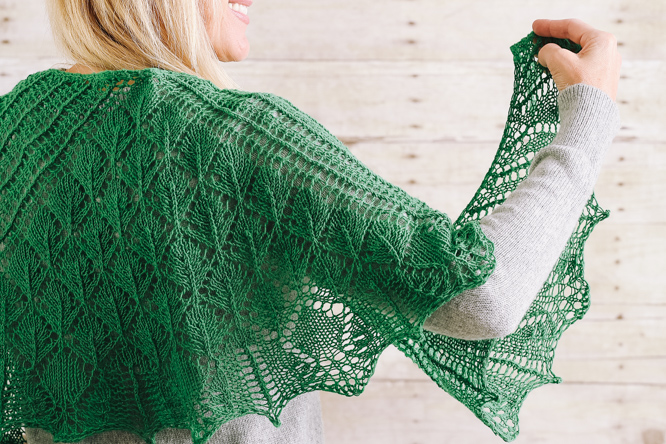
The Leaf Lace Shawl is a crescent-shaped, top-down shawl that’s completely seamless. It features a delicate leafy lace pattern in the center and a textured lace ribbing on the sides, all of which makes this shawl the perfect accessory for a holiday party. All three sections dissolve into a wavy edging that’s finished with a lovely elastic picot bind-off. If you aren’t familiar with that technique, check out our video tutorial below.
Skill Level: Intermediate
Size: 47.2” x 14.9”
Gauge: 19 sts x 24 rows = 4” [10 cm] in St st after wet blocking
Materials
Yarn:
![]() Ovelha Negra Victoria (100% wool; 412 yards [377 meters]/94 grams): #17 (2 balls)
Ovelha Negra Victoria (100% wool; 412 yards [377 meters]/94 grams): #17 (2 balls)
Needles: US size 6 (4.0 mm) 32” circular needles, US size 9 (5.5 mm) straight needles, or sizes needed to obtain gauge
Notions: US size E/4 (3.5 mm) crochet hook, markers, waste yarn for provisional cast on, tapestry needle, pins or wires for blocking
Abbreviations
K4tog: Knit 4 stitches together.
M3: Make 3 sts out of 1 – K1, Yo, K1 into the same st (2 sts increased).
S2kp: Slip 2 sts knitwise at the same time, knit one, then pass the 2 slipped sts over the knitted stitch.
Sk3p: Slip 1 st knitwise, knit 3 sts together, then pass the slipped st over the knitted stitch.
Ssk: Slip 2 sts knitwise, one at a time, then slide the LH needle into the front part of both sts and knit them together through the back loop.
Pattern Notes
Read the pattern carefully before starting.
This pattern is knitted top-down, totally seamless. It starts with three stylish sections that flow into a lace edging finished with an elastic picot bind-off.
Take time to check your gauge. Gauge is listed as a guide for yardage requirements – if you knit to a different gauge or change the number of repeats of main pattern (Chart B), make sure you have the yarn you will need.
The st count varies from one row to the next. I recommend counting the stitches after each repeat and also placing life lines.
The M3 is easier to execute if you work the sts very loosely.
For successful blocking I suggest working the bind-off using with larger needles – US size 9 needles (5.5 mm).
Despite its intricate look, Balada it’s fairly simple to knit and as any modular pattern is adjustable in size by changing the number repeats of main pattern (Chart B) to an even number.

Pattern
CO – garter stitch tab.
With 4.0 mm (US size 6) needles and your favorite provisional method CO 2 sts. Knit 12 rows. Rotate your knitting 90º clockwise, pick up and knit 5 sts along the side of the tab. Carefully pull out the waste yarn and knit the 2 live sts. (9 sts total)
Set-up (Chart A)
Chart is worked only once (20 rows total). Each right side row adds 6 sts.
Row 1 (RS): K2, m3, p1, pm, yo, k1, yo, pm, p1, m3, k2. (15 sts)
Row 2 and all wrong side rows: K2, p to last 2 sts, k2.
Row 3: K2, m3, k2tog, yo, p1, sm, yo, k3, yo, sm, p1, yo, ssk, m3, k2. (21 sts)
Row 5: K3, m3, p1, yo, s2kp, yo, p1, sm, yo, k5, yo, sm, p1, yo, s2kp, yo, p1, m3, k2. (27 sts)
Row 7: K2, m3, p3, yo, s2kp, yo, p1, sm, yo, k7, yo, sm, p1, yo, s2kp, yo, p3, m3, k2. (33 sts)
Row 9: K2, m3, yo, s2kp, yo, p2, yo, s2kp, yo, p1, sm, yo, k9, yo, sm, p1, yo, s2kp, yo, p2, yo, s2kp, yo, m3, k2. (39 sts)
Row 11: K2, m3, p1, (p1, yo, s2kp, yo, p1) twice, sm, yo, k1, yo, k3, s2kp, k3, yo, k1, yo, sm, (p1, yo, s2kp, yo, p1) twice, p1, m3, k2. (45 sts)
Row 13: K2, m3, k2tog, yo, p1, (p1, yo, s2kp, yo, p1) twice, sm, yo, k3, yo, k2, s2kp, k2, yo, k3, yo, sm, (p1, yo, s2kp, yo, p1) twice, p1, yo, ssk, m3, k2. (51 sts)
Row 15: K2, m3, (p1, yo, s2kp, yo, p1) x 3, sm, yo, k5, yo, k1, s2kp, k1, yo, k5, yo, sm, (p1, yo, s2kp, yo, p1) x 3, yo, m3, k2. (57 sts)
Row 17: K2, m3, p2, (p1, yo, s2kp, yo, p1) x 3, sm, yo, k7, yo, s2kp, yo, k7, yo, sm, (p1, yo, s2kp, yo, p1) x 3, p2, m3, k2. (63 sts)
Row 19: K2, m3, yo, s2kp, yo, p1, (p1, yo, s2kp, yo, p1) x 3, sm, yo, k4, k2tog, k2, yo, k3, yo, k2, ssk, k4, yo, sm, (p1, yo, s2kp, yo, p1) x 3, p1, yo, s2kp, yo, m3, k2. (69 sts)
Main pattern (Chart B)
Worked 6 times (30 rows total). Each right side row adds 6 sts. Total stitch count after each repeat: 1st repeat – 99 sts; 2nd repeat – 129 sts, 3rd repeat – 159 sts, 4th repeat – 189 sts, 5th repeat – 219 sts, 6th repeat – 249 sts.
Row 1 (RS): K2, m3, p1, *p1, yo, s2kp, yo, p1* rep to marker, sm, yo, k1, *yo, k3, s2kp, k3, yo, k1* rep to marker, yo, sm, *p1, yo, s2kp, yo, p1* rep to last 4 sts, p1, m3, k2.
Row 2 and all wrong side rows: K2, p to last 2 sts, k2.
Row 3: K2, m3, k2tog, yo, p1, *p1, yo, s2kp, yo, p1* rep to marker, sm, yo, k2, *k1, yo, k2, s2kp, k2, yo, k2* rep to 1 st before marker, k1, yo, sm, *p1, yo, s2kp, yo, p1* rep to last 6 sts, p1, yo, ssk, m3, k2.
Row 5: K2, m3, *p1, yo, s2kp, yo, p1* rep to marker, sm, yo, k3, *k2, yo, k1, s2kp, k1, yo, k3* rep to 2 sts before marker, k2, yo, sm, *p1, yo, s2kp, yo, p1* rep to last 3 sts, m3, k2.
Row 7: K2, m3, p2, *p1, yo, s2kp, yo, p1* rep to marker, sm, yo, k4, *k3, yo, s2kp, yo, k4* rep to 3 sts before marker, k3, yo, sm, *p1, yo, s2kp, yo, p1* rep to last 5 sts, p2, m3, k2.
Row 9: K2, m3, yo, s2kp, yo, p1, *p1, yo, s2kp, yo, p1* rep to marker, sm, yo, k4, k2tog *k2, yo, k3, yo, k2, s2kp* rep to 14 sts before marker, k2, yo, k3, yo, k2, ssk, k4, yo, sm, *p1, yo, s2kp, yo, p1* rep to last 7 sts, p1, yo, s2kp, yo, m3, k2.
Transition (Chart C)
Worked only once (8 rows total).
Note that the number of increases per row will vary (on row 5 and 7 there are no increases in center section).
Row 1 (RS): K2, m3, p1, *p1, yo, s2kp, yo, p1* rep to marker, sm, yo, k1, *yo, k3, s2kp, k3, yo, k1* rep to marker, yo, sm, *p1, yo, s2kp, yo, p1* rep to last 4 sts, p1, m3, k2. (255 sts)
Row 2 and all wrong side rows: K2, p to last 2 sts, k2.
Row 3: K2, m3, k2tog, yo, p1, *p1, yo, s2kp, yo, p1* rep to marker, sm, yo, k2, *k1, yo, k2, s2kp, k2, yo, k2* rep to 1 st before marker, k1, yo, sm, *p1, yo, s2kp, yo, p1* rep to last 6 sts, p1, yo, ssk, m3, k2. (261 sts)
Row 5: K2, m3, *p1, yo, s2kp, yo, p1* rep to marker, sm, k3, *k2, yo, k1, s2kp, k1, yo, k3* rep to 2 sts before marker, k2, sm, *p1, yo, s2kp, yo, p1* rep to last 3 sts, m3, k2. (265 sts)
Row 7: K2, m3, p2, *p1, yo, s2kp, yo, p1* rep to marker, sm, k3, *k3, yo, s2kp, yo, k4* rep to 2 sts before marker, k2, sm, *p1, yo, s2kp, yo, p1* rep to last 5 sts, p2, m3, k2. Remove the markers on next row. (269 sts)
Edging (Chart D)
Worked only once (20 rows total). The pattern st is worked across all the sections of the shawl. Each right side row adds 4 sts.
Row 1 (RS): K2, m3, yo, s2kp, yo, p2, k2tog, yo, k5, *k4, yo, ssk, p2, yo, s2kp, yo, p2, k2tog, yo, k5* rep to last 14 sts, pm, k4, yo, ssk, p2, yo, s2kp, yo, m3, k2. (273 sts)
Row 2 and all wrong side rows to row 18: K2, p to last 2 sts, k2.
Row 3: K2, m3, p2, yo, s2kp, yo, p2, k2tog, yo, k5, *k4, yo, ssk, p2, yo, s2kp, yo, p2, k2tog, yo, k5* rep to marker, sm, k4, yo, ssk, p2, yo, s2kp, yo, p2, m3, k2. (277 sts)
Row 5: K2, m3, k2tog, yo, p2, yo, s2kp, yo, p2, k2, yo, ssk, k3, *k2, k2tog, yo, k2, p2, yo, s2kp, yo, p2, k2, yo, ssk, k3* rep to marker, sm, k2, k2tog, yo, k2, p2, yo, s2kp, yo, p2, yo, ssk, m3, k2. (281 sts)
Row 7: K2, m3, (p1, yo, s2kp, yo, p1) twice, p1, k3, yo, ssk, k2, *k1, k2tog, yo, k3, p2, yo, s2kp, yo, p2, k3, yo, ssk, k2* rep to marker, sm, k1, k2tog, yo, k3, p1, (p1, yo, s2kp, yo, p1) twice, m3, k2. (285 sts)
Row 9: K2, m3, p2, (p1, yo, s2kp, yo, p1) twice, p1, k4, yo, ssk, k1, *k2tog, yo, k4, p2, yo, s2kp, yo, p2, k4, yo, ssk, k1* rep to marker, sm, k2tog, yo, k4, p1, (p1, yo, s2kp, yo, p1) twice, p2, m3, k2. (289 sts)
Row 11: K2, m3, yo, s2kp, yo, p1, (p1, yo, s2kp, yo, p1) twice, p1, sk3p, (yo, k1) x 3, *(yo, k1) x twice, yo, k4tog, p2, yo, s2kp, yo, p2, sk3p, (yo, k1) x 3* rep to marker, sm, (yo, k1) twice, yo, k4tog, p1, (p1, yo, s2kp, yo, p1) twice, p1, yo, s2kp, yo, m3, k2. (293 sts)
Row 13: K2, m3, p1, (p1, yo, s2kp, yo, p1) x 3, p1, k7, *k6, p2, yo, s2kp, yo, p2, k7* rep to marker, sm, k6, p1, (p1, yo, s2kp, yo, p1) x 3, p1, m3, k2. (297 sts)
Row 15: K2, m3, k2tog, yo, p1, (p1, yo, s2kp, yo, p1) x 3, p1, sk3p, (yo, k1) x 3, *(yo, k1) x twice, yo, k4tog, p2, yo, s2kp, yo, p2, sk3p, (yo, k1) x 3* rep to marker, sm, (yo, k1) twice, yo, k4tog, p1, (p1, yo, s2kp, yo, p1) x 3, p1, yo, ssk, m3, k2. (301 sts)
Row 17: K2, m3, (p1, yo, s2kp, yo, p1) x 4, p1, k7, *k6, p2, yo, s2kp, yo, p2, k7* rep to marker, sm, k6, p1, (p1, yo, s2kp, yo, p1) x 4, m3, k2. (305 sts)
Row 19: K2, m3, p2, (p1, yo, s2kp, yo, p1) x 4, p1, sk3p, (yo, k1) x 3, *(yo, k1) x twice, yo, k4tog, p2, yo, s2kp, yo, p2, sk3p, (yo, k1) x 3* rep to marker, sm, (yo, k1) twice, yo, k4tog, p1, (p1, yo, s2kp, yo, p1) x 4, p2, m3, k2. Remove the marker on next row. (309 sts)
Row 20: K across.
With larger needles BO knitwise loosely from the RS using an Elastic picot BO:
K1, (k1, transfer the 2 sts back to LH needle and k2tog through the back loops) x 23, *k next st but don’t drop it off needle, BO1(by passing the first knit st of RH needle over the second st), slip remaining st to LH needle, CO1, BO2, (k1, transfer the 2 sts back to LH needle and k2tog through the back loops) x 19*, rep to last 25 sts, k next st but don’t drop it off needle, BO1 (by passing the first knit st of RH needle over the second), slip remaining st to LH needle, CO1, BO2, (k1, transfer the 2 sts back to LH needle and k2tog through the back loops) to end.
Note: Use the cable cast-on method to CO the 1 st — insert RH needle between the 1st and 2nd st on the LH needle. Wrap the yarn around the needle as if to knit and pull the loop through the front. Slip new stitch onto your LH needle.

Finishing
Secure and weave in ends. Wet block by soaking the shawl in cool water for about 30 min, wring it gently to remove the excess water (you may use a towel instead). Start by placing several pins into the edging and then in the inner edging into a crescent shape.

